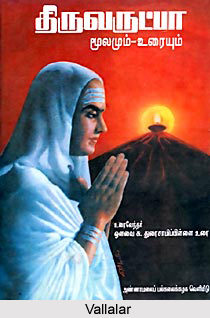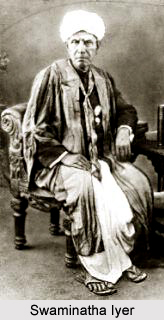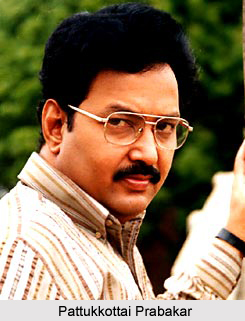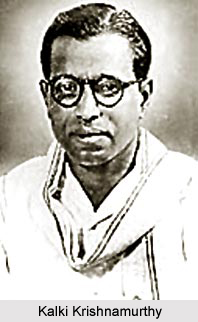 Modern era in Tamil literature basically is counted from the eighteenth and the nineteenth centuries, which very much was into a maturity phase, looking towards a glinting future, as the genres had passed their considerable phases from ancient times. In this context, the 18th and 19th centuries of Tamil Nadu had remained witness to some of the most intense changes in the political scenario. The traditional Tamil ruling clans were ruthlessly replaced by European colonists and their well-wishers. The Tamil society was passing through a profound cultural shock with the infliction of western cultural influences. The Hindu religious organisations solemnly attempted to halt this tide of change and to uphold ancient Tamil cultural values. Notable amongst these organisations were the Saiva monasteries at Tiruvavaduthurai, Dharmapuram, Thiruppananthal and Kundrakudi. Meenakshisundaram Pillai (1815-1876) was a Tamil scholar who taught Tamil at one of these monasteries. He practically had authored over eighty books consisting of more than 200,000 verses. Meenakshisundaram Pillai is however more respected for tremendously boosting U.V. Swaminatha Iyer to go in a serious quest for Tamil books that have been lost for centuries. Gopalakrishna Bharathi, another notable from the modern era of Tamil literature, had existed during the early nineteenth century. He had composed numerous poems and lyrics set in tune with Carnatic music.
Modern era in Tamil literature basically is counted from the eighteenth and the nineteenth centuries, which very much was into a maturity phase, looking towards a glinting future, as the genres had passed their considerable phases from ancient times. In this context, the 18th and 19th centuries of Tamil Nadu had remained witness to some of the most intense changes in the political scenario. The traditional Tamil ruling clans were ruthlessly replaced by European colonists and their well-wishers. The Tamil society was passing through a profound cultural shock with the infliction of western cultural influences. The Hindu religious organisations solemnly attempted to halt this tide of change and to uphold ancient Tamil cultural values. Notable amongst these organisations were the Saiva monasteries at Tiruvavaduthurai, Dharmapuram, Thiruppananthal and Kundrakudi. Meenakshisundaram Pillai (1815-1876) was a Tamil scholar who taught Tamil at one of these monasteries. He practically had authored over eighty books consisting of more than 200,000 verses. Meenakshisundaram Pillai is however more respected for tremendously boosting U.V. Swaminatha Iyer to go in a serious quest for Tamil books that have been lost for centuries. Gopalakrishna Bharathi, another notable from the modern era of Tamil literature, had existed during the early nineteenth century. He had composed numerous poems and lyrics set in tune with Carnatic music.
 Gopalakrishna Bharathi`s most celebrated work is the Nandan Charitam, based upon the life of Nandanar, who having been born in a sociologically lower caste, confronts and subdues the social hindrances in reaching his dream of visiting the Chidambaram temple. This work is a revolutionary social commentary, considering the period in which it was written, redefining modernity of the modern era in Tamil literature; although Gopalakrishna Bharati had elaborated on the story in Periyapuranam. Ramalinga Adigal (also popular as Vallalar) (1823-1874) had penned the devotional poem Tiruvarutpa, considered to be a work of utter exquisiteness and minimalism. Maraimalai Adigal (1876-1950) intensely had pushed for the purity of Tamil and wanted to cleanse it off from words with Sanskrit influences. One of the greatest of Tamil poets from the modern period was Subramanya Bharathi. His works are energising and exhilarating enough in their liberalist themes like `freedom` and `feminism`. Subramanya Bharathi also had brought in an innovative poetic style in the modern era of Tamil literature, encased within a fairly inflexible style of Tamil poetry writing, which had espoused the rules set in the long-back Tolkaappiyam (a treatise on the grammar of the Tamil language and the earliest extant work of Tamil literature). His puthukkavithai (literally standing for `new poetry`) broke the rules and lent poets the license to articulate themselves neatly. Subramanya Bharathi also had penned Tamil prose in the form of commentaries, editorials, short stories and novels. A literary giant of the 20th century, Subramania Bharathi`s poems and patriotic songs are also exceedingly well known. Some of these were printed in the Tamil daily Swadesamitran and in his Tamil weekly India. Increasingly inspired by Bharathi, various poets took to poetry as a means of reformation. Bharathidasan was one such poet falling within this genre. U.V. Swaminatha Iyer, was implemental in resurrecting curiosity in the Sangam age literature in Tamil Nadu. Swaminatha Iyer had journeyed all over the Tamil country, assembling, decoding and issuing ancient books such as Cilappatikaram, Kuruntokai, etc. He had then published more than 90 books and authored En caritham, an autobiography.
Gopalakrishna Bharathi`s most celebrated work is the Nandan Charitam, based upon the life of Nandanar, who having been born in a sociologically lower caste, confronts and subdues the social hindrances in reaching his dream of visiting the Chidambaram temple. This work is a revolutionary social commentary, considering the period in which it was written, redefining modernity of the modern era in Tamil literature; although Gopalakrishna Bharati had elaborated on the story in Periyapuranam. Ramalinga Adigal (also popular as Vallalar) (1823-1874) had penned the devotional poem Tiruvarutpa, considered to be a work of utter exquisiteness and minimalism. Maraimalai Adigal (1876-1950) intensely had pushed for the purity of Tamil and wanted to cleanse it off from words with Sanskrit influences. One of the greatest of Tamil poets from the modern period was Subramanya Bharathi. His works are energising and exhilarating enough in their liberalist themes like `freedom` and `feminism`. Subramanya Bharathi also had brought in an innovative poetic style in the modern era of Tamil literature, encased within a fairly inflexible style of Tamil poetry writing, which had espoused the rules set in the long-back Tolkaappiyam (a treatise on the grammar of the Tamil language and the earliest extant work of Tamil literature). His puthukkavithai (literally standing for `new poetry`) broke the rules and lent poets the license to articulate themselves neatly. Subramanya Bharathi also had penned Tamil prose in the form of commentaries, editorials, short stories and novels. A literary giant of the 20th century, Subramania Bharathi`s poems and patriotic songs are also exceedingly well known. Some of these were printed in the Tamil daily Swadesamitran and in his Tamil weekly India. Increasingly inspired by Bharathi, various poets took to poetry as a means of reformation. Bharathidasan was one such poet falling within this genre. U.V. Swaminatha Iyer, was implemental in resurrecting curiosity in the Sangam age literature in Tamil Nadu. Swaminatha Iyer had journeyed all over the Tamil country, assembling, decoding and issuing ancient books such as Cilappatikaram, Kuruntokai, etc. He had then published more than 90 books and authored En caritham, an autobiography.
 A contemporaneous trend in the modern era of Tamil literature was precisely begun in the 19th century by a group of writers deeply influenced by English, Vedanayakam Pillai (1824-1889) being among them, who had penned the first creative and inventive novels and dramas. Although the development of prose had been slow, the historical romances of C R Srinivasa Aiyangar, social novels like Padmavati and Vijaya Marttandam of A.S. Madhavayya, Kamalambal by Rajam Iyer and S. Venkataramani`s Murugam stand in prominence in the modern period of Tamil literature. The short story was popularised by V V S Iyer and Rajaji, while Sambanda Mudaliar`s classic adaptations of Shakespeare`s plays contributed to Tamil drama greatly and irreplaceably.
A contemporaneous trend in the modern era of Tamil literature was precisely begun in the 19th century by a group of writers deeply influenced by English, Vedanayakam Pillai (1824-1889) being among them, who had penned the first creative and inventive novels and dramas. Although the development of prose had been slow, the historical romances of C R Srinivasa Aiyangar, social novels like Padmavati and Vijaya Marttandam of A.S. Madhavayya, Kamalambal by Rajam Iyer and S. Venkataramani`s Murugam stand in prominence in the modern period of Tamil literature. The short story was popularised by V V S Iyer and Rajaji, while Sambanda Mudaliar`s classic adaptations of Shakespeare`s plays contributed to Tamil drama greatly and irreplaceably.
The novel as a substantial genre of literature had seeped within Tamil in the third quarter of 19th century, more than a century after it had become popular with English writers. The ever swelling population of the Tamil populace with a western education and tremendous exposure to popular English fiction perhaps had facilitated its emergence in the modern era of Tamil literature. Mayuram Vedanayakam Pillai had penned the first Tamil novel, Prathapa Mudaliar Charithram in 1879. This was an out-and-out romance with an assortment of fables, folk tales and even Greek and Roman stories, written keeping in mind the entertainment and enjoyment of the reader as the principal motive. The novel Kamalambal Charitram by B.R. Rajam Iyer in 1893 and Padmavathi Charitram by A. Madhaviah followed it soon in 1898. These two mentioned novels verily portray the life of Brahmins in 19th century rural Tamil Nadu, capturing charmingly their customs and habits, beliefs and rituals. Although it was for the very first feature, a powerhouse narration of the common man`s life in a realistic scenario, zested with raw witticism, Rajam Iyer`s novel possesses a spiritual and philosophical undercurrent and that clandestine air, quite apt for the modern era of Tamil literature. Madhaviah chronicles the story in a somewhat pragmatic and no-nonsense way, enlaced with an incisive criticism of the upper caste of the strata, especially the sexual exploitation of young girls by lecherous old men.
 The ever magnifying demand of the knowledgeable and erudite populace, coming under the modern era of Tamil literature, had stimulated a couple of journals and periodicals to be printed and these in succession, furnished an appropriate platform for authors to issue their work. Some of the most counted-upon and notable earliest Tamil journals comprise: Rajavritti Bodhini and Dina Varthamani in 1855, Salem Pagadala Narasimhalu Naidu`s fortnight publishings, Salem Desabhimini in 1878 and Coimbatore Kalanidhi in 1880. In 1882, G. Subramaniya Iyer began issuing the newspaper Swadesamitran. This had in fact become the first Tamil daily in 1899. Swadesamitran incited the initiation of several other journals to follow and various novelists began to arrange their stories in a serialised manner in these journals. The magazine with a humourous tome, Ananda Vikatan, was initiated by S.S. Vasan in 1929, in order to help create some of the greatest Tamil novelists for years to arrive.
The ever magnifying demand of the knowledgeable and erudite populace, coming under the modern era of Tamil literature, had stimulated a couple of journals and periodicals to be printed and these in succession, furnished an appropriate platform for authors to issue their work. Some of the most counted-upon and notable earliest Tamil journals comprise: Rajavritti Bodhini and Dina Varthamani in 1855, Salem Pagadala Narasimhalu Naidu`s fortnight publishings, Salem Desabhimini in 1878 and Coimbatore Kalanidhi in 1880. In 1882, G. Subramaniya Iyer began issuing the newspaper Swadesamitran. This had in fact become the first Tamil daily in 1899. Swadesamitran incited the initiation of several other journals to follow and various novelists began to arrange their stories in a serialised manner in these journals. The magazine with a humourous tome, Ananda Vikatan, was initiated by S.S. Vasan in 1929, in order to help create some of the greatest Tamil novelists for years to arrive.
Kalki Krishnamurthy (1899-1954) and his short stories and novels were henceforth serialised in Ananda Vikatan and eventually started his own weekly Kalki. Modern era of Tamil literature also shone forthright in its short story genre, due to the man Kalki Krishnamurthy and his strategy in the magazine publishing, for which he had penned the unforgettable novels like Parthiban Kanavu, Sivagmiyin Sabhatham and the hugely admired Ponniyin Selvan. Pudhumaipithan (1906-1948) was a grand writer of short stories and incessantly had supplied the necessary inspiration for a number of authors who succeeded him. Tamil Christian poets also added to the body of Tamil literature in modern times. Vedanayagam Shastriar, Krishna Pillai, and N. Samuel of Tranquebar were titled as the `triumvirate` in the poetry domain.
Crime and detective fiction was one more highly sought after genre in Tamil literature of the modern era that has enjoyed extensive popularity in Tamil Nadu since the 1930s. Well accepted writers in the years before Independence comprised: Kurumbur Kuppusami and Vaduvur Duraisami Iyengar. During the 1950s and 60s, Tamilvanan`s detective hero Shankarlal took his readers to an assortment of foreign loci, while speaking pure Tamil with very few Hindi or English loan words. From the 1980s to the present, top authors in crime fiction in modern Tamil literature comprise: Subha, Pattukkottai Prabakar and Rajesh Kumar (who also pens science fiction and other genres). These writers are often awfully creative, with hundreds or even thousands of short novels to their recognition and one or more short novel issued in a monthly periodical. Indra Soundar Rajan, another iconic modern author, pens supernatural crime thrillers, normally pivoting around Hindu mythology. During the 1950s and 60s, Chandilyan had authored a number of really popular historical romance novels, with the backdrop in medieval India or on medieval trade routes with Malaysia, Indonesia and Europe. Modern romance novels are exemplified by the present-day best-selling author in the Tamil language, Ramanichandran. The sales of Tamil pulp fiction have witnessed its declination since the prime of mid-1990s; as such several writers have turned their interest towards the more profitable and productive television serial market.



















